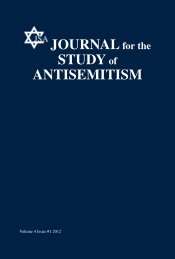Journal for the Study of Antisemitism
Journal for the Study of Antisemitism
Journal for the Study of Antisemitism
You also want an ePaper? Increase the reach of your titles
YUMPU automatically turns print PDFs into web optimized ePapers that Google loves.
2009] BETRAYING TRUTH 181<br />
According to Toameh, in <strong>the</strong> Oslo Years Arafat didn’t build one housing<br />
unit <strong>for</strong> refugees, one road, one university or college, one hospital or<br />
clinic–he only managed to build a casino in Jericho (right across from a<br />
refugee camp).<br />
At various times during <strong>the</strong> intifada Palestinians have claimed that<br />
Israel was strangling <strong>the</strong>m by cutting <strong>of</strong>f electricity to <strong>the</strong> Gaza Strip–a<br />
charge widely reported in <strong>the</strong> world’s media and supported by photographs,<br />
despite evidence to <strong>the</strong> contrary. 165 Toameh was one <strong>of</strong> few Arab journalists<br />
who reported that Hamas staged blackouts to support <strong>the</strong>ir claims. He<br />
said that he was frequently placed in life-threatening situations by Yasir<br />
Arafat’s Palestinian Authority (PA). He noted that at least twelve Palestinian<br />
journalists had been attacked by masked men in a four-month period in<br />
early 2004 in what appeared to be an organized campaign to intimidate <strong>the</strong><br />
media. He told about a photographer working <strong>for</strong> Agence France-Presse<br />
who had his arms broken by a masked man in Ramallah. He observed,<br />
“Agence France-Presse did not do anything about this attack, but a great<br />
outcry is raised when Israeli soldiers allegedly harass journalists in <strong>the</strong><br />
territories.” 166<br />
While a student at <strong>the</strong> Hebrew University in Jerusalem, Toameh<br />
worked <strong>for</strong> <strong>the</strong> Palestinian Liberation Organization’s <strong>of</strong>ficial newspaper Al<br />
Fajr (“The Dawn”). There he saw firsthand <strong>the</strong> lack <strong>of</strong> journalistic freedom<br />
in Gaza. Later he was censured <strong>for</strong> his outspoken and critical views <strong>of</strong> <strong>the</strong><br />
Palestinian media, 167<br />
A controlled empirical study by Yariv Tsfati concluded that hostile<br />
Arab perceptions <strong>of</strong> Israel were generated and nurtured by negative Palestinian<br />
media. Exposure to mainstream Israeli media, on <strong>the</strong> o<strong>the</strong>r hand, did<br />
not yield such a response. 168<br />
Opposing Perceptions<br />
The view propounded in this article–that <strong>the</strong> media <strong>of</strong>ten reflect subtle<br />
and overt biases against Israel–is by no means universal. Various observers<br />
suggest quite <strong>the</strong> opposite–that to ascertain <strong>the</strong> facts about what goes on in<br />
165. See, e.g., Andy Soltis, “It Was Obvious <strong>the</strong> Whole Thing Was Staged,” New<br />
York Post, Jan. 30, 2008, p. 25.<br />
166. Khaled Abu Toameh, “Hamas Staged Some ‘Blackouts,’ Palestinian <strong>Journal</strong>ists<br />
Admit,” Jerusalem Post, Jan. 24, 2008.<br />
167. Khaled Abu Toameh, Telling <strong>the</strong> Truth About <strong>the</strong> Palestinians, supra note<br />
151.<br />
168. Yariv Safati, “Hostile Media Perceptions, Presumed Media Influence, and<br />
Minority Alienation: The Case <strong>of</strong> Arabs in Israel,” <strong>Journal</strong> <strong>of</strong> Communication 57<br />
(2007).














